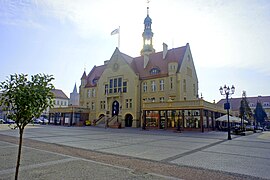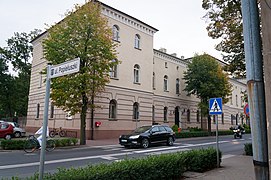Krotoszyn
You can help expand this article with text translated from the corresponding article in Polish. (March 2009) Click [show] for important translation instructions.
|
Krotoszyn | |
|---|---|
 Town Hall | |
|
UTC+2 (CEST) | |
| Postal code | 63–700 to 63–710 |
| Area code | +48 62 |
| Vehicle registration | PKR |
| Climate | Cfb |
| National roads | |
| Voivodeship roads | |
| Website | http://www.krotoszyn.pl |
Krotoszyn
History

Krotoszyn was founded by local nobleman
It developed as a regional center of trade and crafts, located at the intersection of the Kalisz–Głogów and Toruń–Wrocław trade routes.[3] During the Thirty Years' War, in 1628, Protestant refugees from German states settled in the town.[2] It was plundered by the Swedes, during the Swedish invasion of Poland in 1656, but soon recovered and famous fairs were held there.[3]
It was annexed by
Many inhabitants took part in the
World War II

The Germans attacked Krotoszyn on 1 September 1939, the first day of the
During the German occupation the Polish population was subjected to mass arrests,[9] Germanisation policies, discrimination, expulsions, executions[2] and deportations to forced labour in Germany.[10] Poles from Krotoszyn, including several local policemen and the town's deputy mayor, as well as several alumni of local schools, were also murdered by the Russians in the large Katyn massacre in April–May 1940.[11] The Germans destroyed the memorial dedicated to local Polish insurgents of 1918–1919, while another monument plaque was hidden by Poles and thus preserved.[6] Germany also established and operated a Nazi prison in the town.[12] Nevertheless, local Poles managed to organize the underground resistance movement, which included secret Polish teaching, scout troops, a local branch of the Home Army,[2] the Secret Military Organization and structures of the Polish Underground State.[13] Independent underground Polish press was issued in the town.[10]
The town was liberated by
It was within Kalisz Voivodeship from 1975 to 1998.
Economy
The dominant trade is in grain and seeds, and the headquarters of the Polish branch of Mahle GmbH is located there.
Demographics
|
| ||||||||||||||||||||||||||||||
| Source: [14][1] | |||||||||||||||||||||||||||||||
Cuisine
The officially protected traditional food originating from Krotoszyn is wędzonka krotoszyńska, a type of Polish smoked pork meat (as designated by the Ministry of Agriculture and Rural Development of Poland).[15] Local traditions of meat production date back hundreds of years, and the first butchers' guilds were established shortly after granting town rights in the early 15th century.[15]
Sports
The main sports club of the town is Astra Krotoszyn with football and volleyball sections.
Notable people
- Agnieszka Duczmal (born 1946), Polish conductor
- Martin A. Couney (1869–1950), American obstetrician
- Katarzyna Grochola (born 1957), Polish writer
- Georg Huth (1867–1906), German Orientalist
- Isidor Kalisch (1816–1886), reform rabbi
- Judah Aryeh ben Zvi Hirsch (fl. early 18th century), French Hebraist
- Theodor Kullak (1818–1882), German pianist and composer
- Marian Langiewicz (1827–1887), Polish military leader of the January Uprising
- Marcin Lijewski (born 1977), Polish handball player
- John Monasch (1865–1931), General Sir John Monash (change of name) was an innovative strategist in WWI[16]
- Otto Roquette (1824–1896), German author
- Władysław Rybakowski (1885-1952), Polish social and political activist
- Maria Siemionow (born 1950), Polish scientist and microsurgeon
- Melitta von Stauffenberg (born Schiller) (1903–1945), German test pilot of WWII
- Louis Weissbein (1831-1913), architect, immigrated to the United States in 1854
- David Zvi Banet (1893–1973), Orientalist and Professor of Arabic Studies at the Hebrew University in Jerusalem
- Łukasz Kaczmarek (born 1994), Polish volleyball player
International relations
Twin towns – Sister cities
Krotoszyn is
 Bucak, Turkey
Bucak, Turkey Brummen, Netherlands
Brummen, Netherlands- Fontenay le Comte, France
 Dierdorf, Germany
Dierdorf, Germany Maišiagala, Lithuania
Maišiagala, Lithuania Fonyód, Hungary
Fonyód, Hungary
Gallery
-
Historic townhouses at the Market Square
-
GothicSaint John the Baptist church
-
Krotoszyn Town Hall
-
Preserved old wooden church of Saints Fabian, Roch and Sebastian
-
District court
-
Katyn massacre memorial at the local cemetery
References
- ^ a b Stan i struktura ludności oraz ruch naturalny w przekroju terytorialnym w 2010 r. (PDF) (in Polish). Warszawa: Główny Urząd Statystyczny. 2011. p. 104. Archived from the original (PDF) on 13 November 2011.
- ^ a b c d e f g h i j k l m n "Kalendarium do roku 1994 - Paweł Anders". Portal - Krotoszyn - oficjalna strona miasta (in Polish). Retrieved 8 March 2020.
- ^ a b c d e "Krotoszyn - Dzieje Miast". Region Wielkopolska (in Polish). 22 September 2016. Retrieved 8 March 2020.
- ^ a b Chisholm, Hugh, ed. (1911). . Encyclopædia Britannica. Vol. 15 (11th ed.). Cambridge University Press. pp. 928–929.
- ^ "Chopin był w Krotoszynie - odsłonięcie tablicy". Krotoszyn - oficjalna strona miasta (in Polish). Retrieved 3 June 2021.
- ^ a b "Krotoszyn (miasto powiatowe)". Instytut Pamięci Narodowej (in Polish). Retrieved 3 June 2021.
- ^ Wardzyńska, Maria (2009). Był rok 1939. Operacja niemieckiej policji bezpieczeństwa w Polsce. Intelligenzaktion (in Polish). Warszawa: IPN. p. 89.
- ^ Wardzyńska, p. 60
- ^ Wardzyńska, p. 116
- ^ ISSN 1641-9561.
- ^ Łukasz Cichy (7 April 2020). "80 lat od zbrodni katyńskiej. Są również nazwiska z Krotoszyna..." Krotoszyn Nasze Miasto (in Polish). Retrieved 3 June 2021.
- ^ "NS-Gefängnis Krotoschin". Bundesarchiv.de (in German). Retrieved 3 June 2021.
- ISSN 1641-9561.
- ^ Dokumentacja Geograficzna (in Polish). Vol. 3/4. Warszawa: Instytut Geografii Polskiej Akademii Nauk. 1967. p. 23.
- ^ a b "Wędzonka krotoszyńska". Ministerstwo Rolnictwa i Rozwoju Wsi - Portal Gov.pl (in Polish). Retrieved 3 June 2021.
- ^ Wikipedia John Monash








